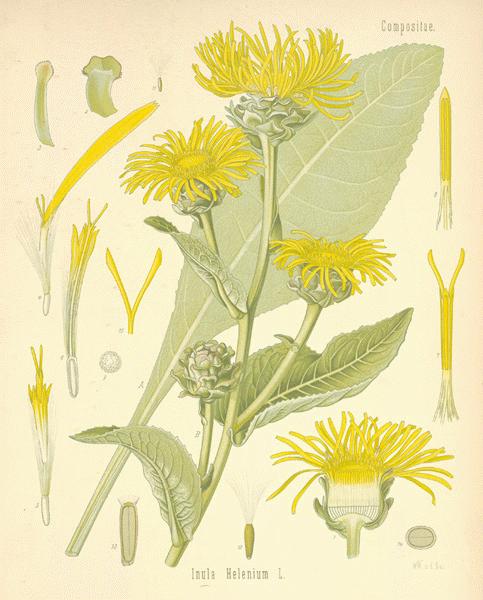|
Elecampane inula helenium Compositae  Constituents The substance most abundantly contained in Elecampane root is Inulin, discovered by Valentine Rose, of Berlin in 1804, who named it Alantin (the German name of the plant is Alantwurzel; French, Aunée), but the title, Inulin proposed by Thompson, has been generally adopted. It has the same composition as starch, but stands to a certain extent in opposition to that substance, which it replaces in the rootsystem of Compositae. In living plants, Inulin is dissolved in the watery juice, and on drying, is deposited within the cells in amorphous masses, which in polarized light are inactive. It resembles starch in appearance, but differs from it in giving a yellow instead of a blue colour with iodine, in being soluble in boiling water without forming a paste, and in being deposited unchanged from the hot aqueous solution when it cools. With nitric acid, Inula affords no explosive compound as starch does. By prolonged heat or the action of dilute acids, it is changed first to inulin then to levulin, and finally to levulose. It is only slightly changed to sugar by ferments. Sachs showed in 1864 that by immersing the roots of Elecampane or Dahlia variabilis in alcohol and glycerine, Inulin may be precipitated in globular aggregations of needleshaped crystalline form. Elecampane is the richest source of inulin. The amount of Inulin varies according to the season, but is more abundant in the autumn. Dragendorff, who in 1870 made it the subject of a very exhaustive treatise, obtained from the root in October not less than 44 per cent, but in spring only 19 per cent, its place being taken by levulin, mucilage, sugar and several glucosides. Inulin is widely distributed in the perennial roots of Compositae, and has been met with in the natural orders Campanulacae, Goodeniaceae, Lobeliaceae, Stylidiaceae, and in the root of the White Ipecacuanha of Brazil, belonging to the order Violaceae. INSULIN USE Source(s) Bibliography Draconian Special Thanks Family and Friends Back - Home - Next |
| |


